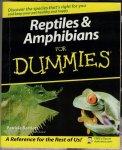- Joined
- Dec 13, 2006
- Messages
- 6,618
- Reaction score
- 102
- Points
- 63
- Location
- Wappingers Falls, NY
- Country
- United States
Reptiles and Amphibians for Dummies by Patricia Bartlett (Indianapolis: Wiley Publishing Inc., 2003) 342 pp.
The books in these Dummies series are often, and surprisingly, good. Ferrets for Dummies, for example, is frequently acknowledged as the best ferret book out there. And this book was not written by any dummy, but by Patricia Bartlett (of Dick and Patricia Bartlett fame). Frank Indiviglio is the technical editor. It is a very promising start.
She begins by distinguishing between reptiles and amphibians and helping the reader choose between them, going into more detail about the biology of the types of each, which takes us to p. 72. Next come a few chapters on purchasing, handling, caging, and caring for herps. Often the info apples to both reptiles and amphibians, and when not, she carefully distinguishes. Part III covers food, water, health, and longevity issues. Part IV is breeding, followed by the legalities of keeping herps. The last section covers immediate health emergencies, ten zoos with great herp collections (I’ve only been to four of them), and other ways to learn more about herps. Finally the appendix gives 1-2 page accounts on many common herp species (sals include: Axolotl, Eastern Newts, Fire, Marbled, and Tiger Salamanders).
A couple of minor points: she doesn’t have very good worm cutting techniques, and she doesn’t talk about the acidity of sphagnum moss.
Dummies books are usually quite comprehensive; they keep reader interest with cartoons, boxes, attention grabbing icons and other gimmicks, and are written with a light heart. This book is no exception. I read the book when I was first becoming interested in herps, both reptiles and amphibians, and it really taught me a lot. I can’t remember how many times I would refer to it. It helped me pick the species of reptiles I chose to get (corn snakes and leopard geckos).
This book is not picture heavy. In the middle are four color pages of reptiles and amphibians. However, I can’t even think of any aspects of herp owning in general that the book doesn’t cover. I highly recommend it, and I guarantee when you finish it you won’t be a dummy anymore.
The books in these Dummies series are often, and surprisingly, good. Ferrets for Dummies, for example, is frequently acknowledged as the best ferret book out there. And this book was not written by any dummy, but by Patricia Bartlett (of Dick and Patricia Bartlett fame). Frank Indiviglio is the technical editor. It is a very promising start.
She begins by distinguishing between reptiles and amphibians and helping the reader choose between them, going into more detail about the biology of the types of each, which takes us to p. 72. Next come a few chapters on purchasing, handling, caging, and caring for herps. Often the info apples to both reptiles and amphibians, and when not, she carefully distinguishes. Part III covers food, water, health, and longevity issues. Part IV is breeding, followed by the legalities of keeping herps. The last section covers immediate health emergencies, ten zoos with great herp collections (I’ve only been to four of them), and other ways to learn more about herps. Finally the appendix gives 1-2 page accounts on many common herp species (sals include: Axolotl, Eastern Newts, Fire, Marbled, and Tiger Salamanders).
A couple of minor points: she doesn’t have very good worm cutting techniques, and she doesn’t talk about the acidity of sphagnum moss.
Dummies books are usually quite comprehensive; they keep reader interest with cartoons, boxes, attention grabbing icons and other gimmicks, and are written with a light heart. This book is no exception. I read the book when I was first becoming interested in herps, both reptiles and amphibians, and it really taught me a lot. I can’t remember how many times I would refer to it. It helped me pick the species of reptiles I chose to get (corn snakes and leopard geckos).
This book is not picture heavy. In the middle are four color pages of reptiles and amphibians. However, I can’t even think of any aspects of herp owning in general that the book doesn’t cover. I highly recommend it, and I guarantee when you finish it you won’t be a dummy anymore.

